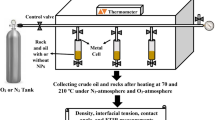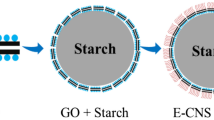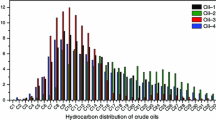Abstract
Large amounts of data regarding the influence of temperature and pressure on the thermal stability of crude oil have been published; however, the role of reservoir mediums has received little attention. Experiments involving oil cracking in the presence of montmorillonite, illite, calcite, quartz and water were conducted in closed gold tubes to investigate the effects of these reservoir mediums on oil destruction. This was done by screening variations in the chemical and stable carbon isotopic components of nC10+ and gasoline-range hydrocarbons (nC8−) present in various systems. Results indicated that reservoir mediums have an active role in oil cracking under experimental conditions. The concentrations of nC10+ in the cracked residues progressively decreased in systems containing oil+water+illite, oil+water+montmorillonite, oil+water, oil+water+quartz and oil+water+calcite. In comparison with the system containing oil+water, our results indicated a retardation effect for oil cracking in systems in the presence of illite and montmorillonite, and an acceleration effect on oil destruction in systems in the presence of calcite and quartz. nC10+ became increasingly depleted in 13C in systems with oil+water+illite, oil+water+calcite, oil+water+montmorillonite, oil+water+ quartz and oil+water. No obvious correlation was observed between concentrations and stable carbon isotopic components of nC6-nC8 and nC10+ in the individual systems. The discrepancies in chemical and stable carbon isotopic components of nC6-nC8 and nC10+ in the pyrolyzed residues highlighted the important role of reservoir mediums to control carbon-carbon cleavage of nC10+ and then the isomerization, cyclolization and aromatization reactions; as well as governing the occurrence and thermal destruction of nC6-nC8 under experimental conditions. This research may have critical implications in reconstructing chemical kinetic models for natural oil cracking.
Similar content being viewed by others
References
Tissot B P, Welte D H. Petroleum Formation and Occurrence. 2nd ed. Berlin: Springer-Verlag, 1984. 1–699
Hunt J M. Petroleum Geochemistry and Geology. 2nd ed. New York: W H Freeman and Company, 1996. 1–617
Mango F D. The origin of light cycloalkanes in petroleum. Geochim Cosmochim Acta, 1990, 54: 23–27
Domine F. High pressure pyrolysis of n-hexane, 2,4-dimethylpentane and 1-phenylbutane: Is pressure an important geochemical parameter? Org Geochem, 1991, 17: 619–634
Horsfield B, Schenk H J, Mills N, et al. An investigation of the in-reservoir conversion of oil to gas: Compositional and kinetic findings from closed-system programmed-temperature pyrolysis. Org Geochem, 1992, 19: 191–204
Domine F, Enguehard F. Kinetics of hexane pyrolysis at very high pressure-3: Application to geochemical modeling. Org Geochem, 1992, 18: 41–49
Price L C. Thermal stability of hydrocarbons in nature: Limits, evidence, characteristics, and possible controls. Geochim Cosmochim Acta, 1993, 57: 3261–3280
Jackson K J, Burnham A K, Braun R L. Temperature and pressure dependence of n-hexadecance craking. Org Geochem, 1995, 24: 941–953
Behar F, Vadndenbroucke M. Experimental determination of the rate constants of the nC25 thermal cracking at 120, 400 and 800 bars: Implications for high-pressure/high-temperature prospects. Energy Fuels, 1996, 10: 932–940
Schenk H J, Di Primio R, Horsfield B. The conversion of oil into gas in petroleum reservoirs. Part I: Comparative kinetic investigation of gas generation from crude oils of lacustrine, marine and fluviodeltaic origin by programmed-temperature closed-system pyrolysis. Org Geochem, 1997, 26: 467–481
Waples D W. The kinetics of in-reservoir oil destruction and gas formation: Constraints from experimental and empirical data, and from thermodynamics. Org Geochem, 2000, 31: 553–575
Machel H G. Bacterial and thermochemical sulfate reduction in diagenetic settings-old and new insights. Sediment Geol, 2001, 140: 143–175
Domine F, Bounaceur R, Scacchi G, et al. Up to what temperature is petroleum stable? New insights from a 5200 free radical reaction model. Org Geochem, 2002, 33: 1487–1499
Xiao Q L, Sun Y G. Petroleum generation and preservation within an overpressured system in sedimentary basins (in Chinese). Geochimica, 2007, 36: 375–382
Goldstein T P. Geocatalytic reactions in formation and maturation of petroleum. Bull Am Assoc Petrol Geol, 1983, 67: 152–159
Tannenbaum E, Kaplan I R. Low-Mr hydrocarbons generated during hydrous and dry pyrolysis of kerogen. Nature, 1985, 317: 708–709
Pepper A S, Dodd T A. Simple kinetic models of petroleum formation. Part II: Oil-gas cracking. Marine Petrol Geol, 1995, 12: 321–340
Zhao W Z, Wang Z Y, Zhang S C, et al. Cracking conditions of crude oil under different geological environments. Sci China Ser D-Earth Sci, 2008, 51(Suppl 1): 77–83
Alexander R, Kagi R I, Larcher A V. Clay catalysis of aromatic hydrogen-exchange reactions. Geochim Cosmochim Acta, 1982, 46: 219–222
Hunt J M. Generation and migration of light hydrocarbons. Science, 1984, 226: 1265–1270
Siskin M, Katritaky A R. Reactivity of organic compounds in hot water: Geochemical and technological implications. Science, 1991, 254: 231–237
Hoering T C. Thermal reactions of kerogen with added water, heavy water and pure organic substances. Org Geochem, 1984, 5: 267–278
Surdam R C, Crossey L J, Hagen E S, et al. Organic-inorganic interactions and sandstone diagenesis. Bull Am Assoc Petrol Geol, 1989, 73: 1–23
Helgeson H C, Knox A M, Owens C E, et al. Petroleum, oil field waters, and authigenic mineral assemblages: Are they in metastable equilibrium in hydrocarbon reservoirs? Geochim Cosmochim Acta, 1993, 57: 3295–3339
Hutcheon I, Abercrombie H J. Carbon dioxide in clasitic rocks and silicate hydrolysis. Geology, 1990, 18: 541–544
Hutcheon I, Shevalier M, Abercrombie H J. pH buffering by metastable mineral-fluid equilibria and evolution of carbon dioxide fugacity during burial diagenesis. Geochim Cosmochim Acta, 1993, 57: 1017–1027
Seewald J S. Evidence for metastable equilibrium between hydrocarbons under hydrothermal conditions. Nature, 1994, 370: 285–287
Seewald J S. Organic-inorganic interactions in petroleum-producing sedimentary basins. Nature, 2003, 426: 327–333
Liu J Z, Tang Y C. An example for predicting methane generation by kerogen kinetic experiment (in Chinese). Chinese Sci Bull, 1998, 43: 1187–1191
Hill R J, Tang Y C, Kaplan I R. Insights into oil cracking based on laboratory experiments. Org Geochem, 2003, 34: 1651–1672
Wang Y P, Zhang S C, Wang F Y, et al. Thermal cracking history by laboratory kinetic simulation of Paleozoic oil in eastern Tarim Basin, NW China, implications for the occurrence of residual oil reservoirs. Org Geochem, 2006, 37: 1803–1815
Tian H, Wang Z M, Xiao Z Y, et al. Oil cracking to gases: Kinetic modeling and geological significance. Chinese Sci Bull, 2006, 51: 2763–2770
Zhao W Z, Wang Z Y, Zhang S C, et al. Oil cracking: An important way for highly efficient generation of gas from marine source rock kitchen. Chinese Sci Bull, 2005, 50: 2628–2635
Xiao Q L. Light hydrocarbons as indicators of natural oil cracking from laboratory to field studies (in Chinese). Dissertation for Doctor Degree. Guangzhou: Guangzhou Institute of Geochemistry, Chinese Academy of Sciences, 2009. 1–136
Hoefs J. Stable Isotope Geochemistry. Berlin Heidelberg: Springer-Verlag, 2004. 1–244
Galimov E M. Isotope organic geochemistry. Org Geochem, 2006, 37: 1200–1262
Lewan M D. Experiments on the role of water in petroleum formation. Geochim Cosmochim Acta, 1997, 61: 3691–3723
Author information
Authors and Affiliations
Corresponding author
About this article
Cite this article
Xiao, Q., Sun, Y. & Zhang, Y. The role of reservoir mediums in natural oil cracking: Preliminary experimental results in a confined system. Chin. Sci. Bull. 55, 3787–3793 (2010). https://doi.org/10.1007/s11434-010-4178-0
Received:
Accepted:
Published:
Issue Date:
DOI: https://doi.org/10.1007/s11434-010-4178-0




